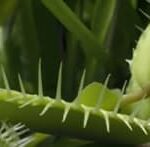As an Amazon Associate, this site earns commissions from qualifying purchases. For more details, click here.
Knowing the signs of a dying Venus flytrap is essential for anyone who wants to grow this carnivorous plant. A lot of these unfortunately die due to lack of information, so it is a good idea to learn what the signs are and what can be done about it.
A Venus flytrap loses all its leaves and turns black before dying quickly. In contrast, a dormant Venus flytrap still has a few green leaves and will continue to grow, albeit slowly.
Is My Venus Flytrap Dead or Dormant?
Venus flytraps die quickly. Once they exhibit the symptoms – turning black, losing leaves, drooping, traps stop closing etc. – the plant rapidly sheds off its leaves and dies. Root rot can kill a Venus flytrap and all that will be left is blackened stuff that used to be the plant.
A dead Venus flytrap has no leaves and is all black with a mushy feel to it. A dormant Venus flytrap usually retains a few green leaves. If it is fall and the plant starts discarding its leaves, it is likely going into dormancy.
Dormant Venus flytraps exhibit many of the same signs, which is why some people mistake it for dying. But there are some differences you need to know.
The easiest way to tell if a Venus flytrap is dead or dormant is to check the calendar. If it is fall, the plant is probably going into dormancy. If it is spring or summer, it is likely dying.
Venus flytraps go into dormancy slowly. The plant turns black -which you can safely cut off – and loses leaves over a period of many weeks. Even a fully dormant flytrap usually has a few green leaves.
If you still are not sure, just wait 6-8 weeks. If the Venus flytrap is dormant it should reemerge and show signs of life. But if the plant remains in the same condition, it is probably dead already.
Do not touch the Venus flytrap when it is under this condition. You should also avoid watering the plant too much.
If you really want to know if the plant is dead or dormant, check its rhizome (also known as the bulb). If it is white the plant is still alive, but if it is black and mushy, the plant is dead or dying. Do this only if you are repotting the plant.
How to Save a Dying Venus Flytrap
A dying Venus flytrap can still be saved by using the right soil mix and water. With enough light and food, there is a chance to save it.
You will need:
New soil mix. Our choice is Perfect Plants Carnivorous Plant Soil because it works well with carnivorous plants.
New pot
Distilled water. We recommend Resway Distilled Water because it is safe for these plants.
This will only work if the plant is still alive. So make sure your Venus flytrap is still living before proceeding.
- If your Venus flytrap shows symptoms it is dying, carefully remove it from its container. If the rhizome is black and soft, the plant is indeed sick. Remove any rotted roots and leaves.
- Do not use regular soil. Mix long sphagnum moss with perlite or sand. Or you can buy ready made Venus flytrap soil and follow instructions for use.
- Water the plant with rain, distilled or reverse osmosis water. Do not use tap water as it contains minerals that will kill the plant.
- Keep the soil moist at all times. Place the container on a tray. Fill the tray with an inch of water. Refill the tray when the water starts going down.
- Move the plant outdoors so it can get direct sunlight. Up to 7-12 hours of sunlight is ideal. You can also do this indoors under fluorescent lights, but sunlight is better.
- Give the plant time to recover. You have nothing to lose by waiting.
- If the Venus flytrap shows signs of recovery, resist the urge to give it food right away. Allow the leaves to grow again.
- If the traps are still weak, give one of the traps a dead bug to feed on. Cut the bug into small bits. Fill one of its traps, about one third full. You can also try a few bits of fish food or mealworms.
Let your Venus flytrap make a full recovery. Keep it away from pets and anyone or anything that might disturb it. Do not fertilize the soil. As the plant recovers, water it as you would a healthy Venus flytrap.
Can You Bring a Dead Venus Flytrap Back to Life?
First, it is normal for individual traps to die. A trap can usually close five times before dying. This is normal even in healthy Venus flytraps. Once a trap dies it gets replaced by a new one. A healthy plant can have 10 flytraps or more.
A dead Venus flytrap cannot be revived. But a dormant Venus flytrap can be brought back to life with sunlight, water and food.
To revive a dormant Venus flytrap, follow these steps.
- During dormancy, do not disturb the plant. If it is too cold outside bring your flytrap indoors, but store it in a cold container. Check your hardiness zone for details
- Do not feed the traps any kind of food.
- Do not touch the plant, especially the traps.
- Do not water the plant unless the soil is dry. As long as the soil is moist that is sufficient.
If you left your Venus flytrap outside, you do not have to do a lot. The plant will slowly emerge in spring. Make sure it receives plenty of sunlight. Repot the plant if necessary. Do not feed the traps as there are plenty of insects outdoors.
If you moved your Venus flytraps indoors, move them back out after dormancy. Do not expose them to full sunlight yet, just a little bit. Increase their sunlight exposure every few days.
It is a good idea to repot Venus flytraps after it emerges from dormancy. Check its rhizome, the section between its roots and leaves. If it is white, the plant is healthy, but if it is black and mushy, the Venus flytrap is dying or dead.
But you should be able to tell if a Venus flytrap is healthy or not even before checking its rhizome. A Venus flytrap, like other plants, exhibits telltale signs whether it is healthy or infected with a disease.
How Do I Know if My Venus Flytrap is Healthy?
Prevention is better than cure, and that applies to Venus flytraps too. Knowing what it looks like healthy is the key to keeping it that way. Once you notice something different, you can take steps to save the plant.
A healthy Venus flytrap has vibrant green leaves and red lobes. Its traps close on prey quickly and will flower. Its rhizome is white and has a solid consistency.
The lobes are the traps which close on a prey. In a healthy Venus flytrap, these lobes are red and supple. They are open so you can see the hair triggers, which should be straight up.
The outer lobes are green, just like the other leaves. When a bug triggers the sensors the trap closes in less than a second.
Only healthy Venus flytraps can flower. These plants use a lot of energy to do this, so it is a sign of good health.
If you let the flower grow, the plant will have smaller traps. If you prefer larger traps, cut the flower stem before it grows any larger. The plant will not be harmed and instead use its resources to grow bigger traps.
Venus flytraps need sunlight, water and nutrients. Flies, spiders, gnats and other insects are their primary source of nutrients, but you can also give them mealworms. These are just as good for Venus flytraps as bugs and they make less of a mess too.
A Venus flytrap also needs dormancy to stay healthy. Deprived of dormancy the plant could die, as it is a part of its life cycle.
Just let the plant go through its dormant stage as fall approaches. It is normal for Venus flytraps to turn black at this point. Again you should not confuse this with dying and rot as this is part of its life cycle.
Conclusion
Healthy Venus flytraps can live up to 20 years. All it takes is proper care and knowing the signs of sickness so you can take preventive steps. With these in mind you should feel more confident about cultivating Venus flytraps.

My fascination with carnivorous plants began many, many years ago with Venus Fly Traps. Now I am more than happy to impart what I know with other enthusiasts and those who are curious about meat eating plants.



